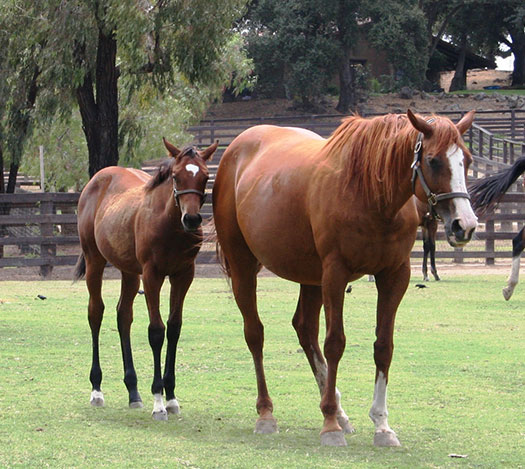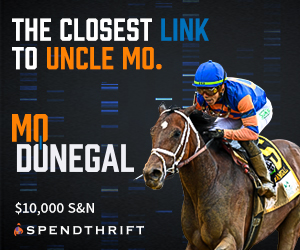
Steve Zorn
Auction prices for proven broodmares and broodmare prospects soared this week, at least at the top end of the market. Seventy-two (a healthy 56.7%) of the 127 mares in the catalog at Fasig-Tipton’s “Night of Stars” on Sunday night were sold, bringing a total of $70,582,000, for an astonishing average price of $980,306, though the median was a more earthbound $400,000. And, led by the $9.5 million paid for Breeders Cup champion Monomoy Girl, 22 mares went for more than $1 million each. That far surpasses last year’s Fasig-Tipton sale, when 80 mares sold for a total of $61,280,000, an average of “just” $766,000, with 17 going for a million or more.
Five mares were sold for $4 million or more: Monomoy Girl, Midnight Bisou ($5 million), Rushing Fall ($5.5 million), Uni ($4.1 million), and Bast ($4.2 million). Another, Flawless, was an RNA at $4.1 million.
And Monday night, in the first session of Keeneland’s mammoth November breeding stock sale, 90 more mares with classy pedigrees and/or stellar racetrack records (60% of the 150 that were in the catalogue) sold for a total of $43,675,000, an average of $485,278, with nine going for $1 million or more. That was pretty close to last year’s comparable Keeneland figures, if not the huge gain that Fasig-Tipton, buoyed by Monomy Girl, Midnight Bisou and friends, showed.
(A quick sidebar: these Fasig-Tipton and Keeneland figures exclude weanlings, so they differ from the totals published by the auction companies that combine both the mares and the weanlings offered in the same session.)
Why would someone pay a million or more for a mare that’s going to spend the rest of her life making babies that may – or may not – sell for a lot of money some years into the future? And we aren’t talking the hundreds of foals a year that stallions can produce; we’re talking one a year, and for, maybe, 10 years at the most, 12 if the mare started young and manages to produce good racing stock until she’s old. Some of the mares (Monomoy Girl among them) may actually race for another year or two before heading to the breeding shed, so that’s likely to recoup at least a bit of the astronomical purchase price. But for most of the mares in the November sales, their future is in producing new race horses.
In some cases, those new race horses will run in the colors of the farms that own the mare. For example, bio-tech millionaire Larry Best’s OXO Equine has been buying at the top of the market the last few years, looking to breed a home–grown Kentucky Derby or Breeders Cup winner. Best got his first Kentucky Derby starter in 2018 with auction purchase Instilled Regard, who later went on to win the Grade 1 Manhattan at Belmont, but now he’s trying, as many well-off owners do, to breed the best to the best and hope for the best (pun intended). Spendthrift Farms, a big player at this year’s Fasig-Tipton sale with four million-dollar plus mares, will probably race most of those mare’s offspring in owner B. Wayne Hughes’s colors, as well as syndicating some of them through myracehorse.com, as they did this year with Derby and BC Classic winner Authentic.
So that’s two justifications for buying a million-dollar mare: (1) wanting to have a high-level homebred and having enough money so cost is not an issue in getting one; and (2) already owning a group of high-level stallions, so the marginal cost of breeding the mare to one of those stallions is minimal.
But what about a breeder who doesn’t race, doesn’t own a stallion station and who intends to sell all a mare’s offspring before they’re ready for the racetrack? Does it make any sense at all to spend $1 million or more? Let’s look at the economics.
A million-dollar mare is likely to go to a pretty high-priced stallion. Although stud fees have come down a bit this year, the top of the stallion market is still pretty expensive. So, let’s say a mare owner will spend an average of $125,000 a year for stud fees, unless, of course, the stallion owner is also the mare owner, as in the case of Spendthrift, Coolmore, Winstar and other large farms that both stand stallions and maintain a broodmare band.
For most mares, their most productive period is up to about age 12. So, if you buy a five-year-old mare off the racetrack, that gives you only seven potentially profitable mating opportunities. At an average of $125,000 a year, that’s $875,000 in stud fees. Then there’s perhaps $25,000 a year in upkeep for the mare, foaling expenses and care of the babies until they go to the sales. For seven years and seven babies, that’s another $175,000. So, we’re up to a bit over a million in expenses. And don’t forget that $1 million or more that the breeder initially paid for the mare. And when the babies go to the sales, the consignor and the auction company get 5% each, so those seven foals will need to bring in about $2.2 million in total, or over $315,000 each, for the breeder to “get out” on the mare by the time she reaches age 12.
And that’s assuming that the mare gets in foal every time, doesn’t miscarry any of the foals, and that the foals grow up healthy enough to make it to the sales. A more likely scenario is that, out of those seven matings, there will be, on average, five foals that can go to the auction ring. The breeder will save a little on stud fees, so the total expenses will drop by $250,000, but with fewer babies that do reach the sales ring, each will now need to average nearly $400,000 for the mare’s owner to break even. That’s a tall order. In Book One at this year’s Keeneland September yearling sale – where the cream of the yearling crop is offered – the sales price averaged $360,000, and the median was $300,000. And that’s only for those that sold and were not RNA’d or scratched. Even in five tries from that million-dollar mare, can you expect to average better than the Book One figure, or can you expect to hit a million-dollar home run with a yearling that will get your purchase price back all at once? Not impossible, but certainly not likely.
As is the case in yearling and two-year-old sales, it seems that buying at the top of the market is not necessarily the best business plan. There are exceptions, for farms that stand high-level stallions and for folks who intend to race their homebreds and who have the means to patronize those top stallions without worrying about the cost. But, for a commercial breeder hoping to recoup their costs at the sales, the economics are daunting.
Photo Courtesy of CTBA


